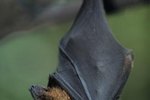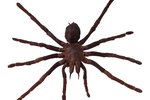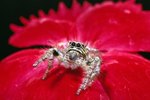
Throughout history, spiders have sparked fear and loathing in humans. While it's true they don't help themselves by creeping about quietly in dark places, the screaming and rolled-up magazine swats are generally unwarranted. Most spiders are virtually harmless and even beneficial to your home and environment. The southwestern state of Oklahoma is host to hundreds of spider species, some more common than others. Only two species are considered dangerous to humans.
Web Builders
Orb weavers, also called garden spiders, are the most common web-builders found in Oklahoma. Hundreds of orb weaver species inhabit the state, but the largest and most frequently encountered is Argiope. Their bodies can reach up to an inch in diameter and are ostentatiously marked in yellow, orange, black or silver. They are easily identified by their webs. They weave extensive labyrinths (up to three feet in diameter) consisting of concentric circles and spokes that radiate from the center to anchor points on trees, shrubs, light fixtures or porch posts.
Ground Dwellers
The most common ground-dwelling spiders in Oklahoma, according Oklahoma State University, are tarantulas, wolf spiders and jumping spiders. Tarantulas are the largest spiders found in the state. They are stout, brown or black in color and covered with fine, prickly hairs. Wolf spiders are nocturnal hunters frequently found indoors during cold weather. They are brown or gray, hairy and often marked with line patterns. Jumping spiders are small, stocky critters with brightly colored bodies. They have a distinctive eye pattern -- three or four pairs with two large eyes in the center.
Venomous Spiders
Two spiders in Oklahoma are considered dangerous, according to Oklahoma Poison Control. The black widow has a rounded, glossy black body and a red, orange or yellow hourglass shape on its abdomen. The brown recluse is light tan to dark brown, with no body hair. It may be distinguished by a violin-shaped mark on its midsection, but that mark is not always visible. It has an unusual eye pattern: three pairs arranged in a semi-circle on the front of its head. If a bite from either spider is suspected, immediate medical attention should be sought.
Environmental Benefits
Spiders counter their scary reputation by being beneficial to your environment and an important link in nature's food chains. As predators, spiders help control insect populations that may otherwise become bothersome to you and destructive to lawns, gardens and crops. As prey, they are a vital food source for birds, rodents, reptiles and amphibians.
References
- Oklahoma State University Cooperative Extension: Spiders: Brown Recluse, Black Widow, and Other Common Spiders
- Oklahoma Poison Control: Spiders
- Oklahoma State University: Oklahoma School IPM: Common Spiders
- Oklahoma State University: Entomology & Plant Pathology
- Bug Guide: Family Araneidae - Orb Weavers
Resources
Photo Credits
-
Hemera Technologies/Photos.com/Getty Images
Writer Bio
Yvette Sajem has been a professional writer since 1995. Her work includes greeting cards and two children's books. A lifelong animal advocate, she is active in animal rescue and transport, and is particularly partial to senior and special needs animals.




